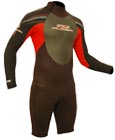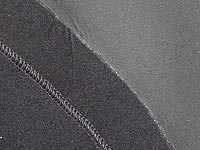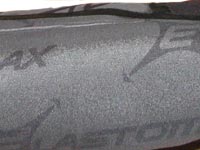SURFING WETSUITS GUIDE
NOTE: This wetsuit guide is generally based on our experience with surfing wetsuits. There are many other wetsuits for different sports and water activities, but with the popularity of surfing, money invested by the big surf wear companies and the fact that surfing is very demanding on the wetsuit, surfing wetsuits are among the best and most versatile wetsuits out there. Surfing demands an unlimited range of movement from the wetsuit, warmth for long surf sessions in cool water and a good look. Therefore this wetsuit guide can be easily also used for wetsuits for windsurfing, kite surfing, wakeboarding, rafting, swimming, rafting, kayaking etc. Only wetsuits designed for scuba diving are vastly different. Some reasons why will be listed below. But still neoprene is neoprene and you can learn a lot from this guide.
WHERE AM I GOING TO USE THE WETSUIT?
First thing you need to ask yourself when buying a wetsuit is – “When and where am I going to surf?” The location and the season more or less determine the water temperature and that is the first thing to consider when buying a wetsuit. Do I look for a shorty, full suit, thick steamer maybe with booties, integrated hood and gloves? If you tend to travel to different places for surf we generally find a long wetsuit to be more versatile and useful than a shorty. Then again, if you are lucky enough to live on an tropical island and surf in sun and warm water and you consider a day with temperatures below 24 degrees to be a cold one, then you can stop reading this guide (you lucky son of a… ). Now let us move on and get more specific.
WETSUITS AND NEOPRENE
Wetsuits – also called neoprene suits are made (surprisingly) from neoprene. Neoprene is an elastic synthetic rubber material with good insulation properties. You can see what the neoprene sheet looks like above. Considering which body parts the neoprene covers we divide wetsuits:
- Shorty – neoprene only covers the body and upper parts of the arms and legs
- Full suit – neoprene covers the body, arms and legs to your wrists and ankles and possibly also the head when the wetsuit has integrated hood
- Spring suit – neoprene covers the body and usually legs and upper arms, but vice versa combination is also possible – neoprene entirely covers the arms and only upper parts of the legs.




Another big warmth factor is the thickness of the neoprene, but more on that a little later, when we explain how wetsuits works.
HOW DOES A WETSUIT WORK?
The basic thing that a wetsuit does to keep us warm is this – the wetsuit catches a thin layer of water between our skin and the neoprene. Body heat warms this layer of water and we are all warm and comfortable in the freezing surroundings. The better the fit of the wetsuit, the warmer we are. Because every time we fall, wipe out and duck dive, cold water wants to enter the wetsuit and flush the warm water out. That is how we get cold. Cold water can penetrate the wetsuit in a number of places:
- Through the spaces for your head, hands and feet
- Through stitches that keep the wetsuit together
- Through the zipper
Another warmth factor is isolation from the environment - this depends on the thickness of the neoprene.
WETSUIT THICKNESS
Wetsuit thickness or the neoprene thickness is the insulation between us and the forces of nature. Wetsuit thickness is usually given with two numbers like 3/2, 4/3, 5/3, or three numbers like 5/4/3. The numbers mean that the thickness of the neoprene is 3 millimetres (or 4 or 5) on the body (and legs with winter suits) and 2 millimetres on arms (and legs with spring suits). The variable thickness of the wetsuit is better and easier movement of our limbs that move a lot between our surfing, windsurfing, rafting, swimming, kayaking, kite surfing etc. This is also the reason that some cheaper wetsuits or for instance wetsuits for divers have only one thickness. Divers do not have to (and in fact should not) move much to keep the heart rate low (we do not know much about diving so please, if we are wrong …) and their range of movement is much smaller than lets say when paddling a surfboard.
A 3/2 wetsuit is generally suited for summer and autumn surfing windsurfing, swimming, kite surfing etc… , while 4/3 wetsuit and 5/3 wetsuit keeps us warm when surfing in winter and spring. The real dry suits and wetsuits with neoprene thicker than 5mm (OK, with exception of some surfers in Norway, Alaska and other really cold places that surfing has spread to) are to clumsy to surf or do any other sport that requires free movement. On the other hand wetsuits with only 2 millimetres of neoprene thickness often stretch and become loose quicker.
WETSUIT FLUSHING
Cold water wants to get into your wetsuit. That is why the most important thing to look for when buying a wetsuit is the right size. The better the wetsuit fits us, the less flushing through holes for our head, hands and feet we get and the less place we leave for the cold water. Even the best, warmest, high-tech, feature packed and solar panel integrated heating system with ipod wetsuit won’t help, if it's too big. Lucky for us, the modern neoprene is stretchy and elastic so it fits and hugs our body better that old wetsuits. Also note, when trying a wetsuit, which will probably be dry in you’re not buying it from someone’s back – wet neoprene is looser and feels a bit bigger than dry neoprene. So if a dry neoprene feels a little tight it is very likely that a wet one won’t. The wetsuit should really hug our skin everywhere – snug fit. But don’t go too far – without making us crouch because it’s so tight we can’t stand up straight.
WETSUIT STITCHES
Now we are moving on to the next factor with cold water flushing our wetsuit – the stitches. The deal on stitches is simple – to stitch neoprene together you need a thread and a needle. Needle makes holes in neoprene. Water and wind use holes to get inside the wetsuit. Less holes through the neoprene – warmer wetsuit.
OVER LOCK STITCH
Over lock stitch is the thing of the past or maybe it is still the thing of the cheap, thin tourist wetsuits. You can recognise it by the big stitches on the inside of the wetsuit that stick out of the neoprene and can therefore also be uncomfortable. Over lock stitch is very strong, but leaves a lot of needle holes for water and wind to flush the wetsuit. Conclusion: cheap wetsuit, durable, strong, for summer wetsuits, for beginners (not very flexible).
FLAT LOCK STITCH
Is what replaced over lock stitches. It looks better and the wetsuit is more comfortable, but the stitch itself leaves the same amount or even more holes in the neoprene. No improvement for warmth here. Flat lock stitch is strong, but the thread is exposed on the outside of the wetsuit and is therefore more likely to tear. Conclusion: still pretty cheap wetsuit, strong and durable, for summer surfing and also good performance for demanding surfers (flexibility).
BLIND STITCH
Blind stitch is the stitch for the warm wetsuits. It has more versions that have different effect on warmth, durability, flexibility and price of the wetsuit. Wetsuits that made using blind stitches which are “waterproof” are called steamer.
All wetsuits that have blind stitch are made in a similar way. First the neoprene is glued together. Then a curved needle brings the thread through the neoprene in such way, that it exits on the same side that it went in, without punching through the neoprene. The result is watertight stitch with no holes through the neoprene. But there is a problem. The elasticity of the neoprene is different from the elasticity of the glue. And together with salt water and sun the glue cracks up and opens the stitch from the inside. That means you have to repair the stitches.
On the picture you can see the blind-stitch from the outside, on the other-side you can not see the thread, just glued neoprene panels. Conclusion: warm wetsuit, flexible (of course also depending on the neoprene type and thickness), variable durability and expensive.

BLIND STITCH, GLUED & SPOT TAPED
Blind stitch, glued and spot taped is the same as above with the addition of taping the stress points of the wetsuit. Stress points are places where three or more stitches come together. This stitch is common with super stretchy high performance wetsuits, where durability is not in the first place.
DOUBLE BLIND STITCH & GLUED
Double blind stitch is first sawn the same way as the above basic blind stitch. Then the neoprene is turned around and is sewn again from the other side. This is a good compromise used with cheaper winter wetsuits. The problem is that sometimes holes from stitches from one side link to holes from the other side and we have some holes that go the whole way through the neoprene. And again we get some flushing. Conclusion: warm wetsuit, flexible (of course also depending on the neoprene type and thickness), durable and reasonably priced.

BLIND STITCH, GLUED & FULLY TAPED
All the inner parts of stitches are completely covered and glued at high temperature and with special tape. That means no opening of the stitches and no water. This type of stitch is very time consuming to make and therefore expensive. Conclusion: very warm wetsuit, OK flexibility (not the best), durable and expensive.
BLIND STITCH, GLUED & FULLY TAPED with NEOPRENE TAPE
Instead of taping the stitches of the wetsuit with special tape at high temperature they are taped with glue and neoprene tape. This eliminates the lower flexibility of the taped stitches. Conclusion: very warm wetsuit, flexible (of course also depending on the neoprene type and thickness), durable and very expensive.
LIQUID TAPING
Also called S or Super Seal or something else, depends on which company uses it. Liquid taping is pretty new wetsuit invention. Special rubber is used when sewing the neoprene to seal the inner or/and outer side of the stitches. That makes them stronger and additionally closes any holes. 100% waterproof stitches!
So basically now you are doctor of wetsuit stitches and know more than enough about them. Every year companies come up with new ways of stitching and gluing neoprene, some more useful some less, but these are the basics. Now we move on to the third wetsuit flushing factor – the zipper.

WETSUIT ZIPPERS
ZIPPER
Zipper helps us get into and out of our wetsuit. The longer the zipper the easier that process is. But the longer the zipper the more flushing you can get through it. So some winter wetsuits have special, short zippers. Also the size and shape of the teeth on the zipper has some influence on the flushing. Note also that metal zippers are more durable than plastic ones. We are talking about the part that slides up and down, the teeth of the zipper are always plastic. There is also a small Velcro safety belt that stops the zipper from opening.
BAT FLAP / BAT WING / DRAIN HOLE etc
With some winter wetsuits an additional piece of neoprene is put under the zipper. This neoprene membrane is thin and stretchy so it doesn’t bother you too much when putting on a wetsuit. But it stops the water that comes through the zipper and keeps it away from our body. On the picture you can see an example of such a membrane – Batwing from Rip Curl.

ZIPPERLESS WETSUITS
How to get into a wetsuit that has no zipper? Again almost every wetsuit company has its own zipper-less system that more or less successfully lets you into the suit. The benefits of this system are of course no flushing through the zipper and better fit and flexibility. Without the zipper the neoprene on our back, chest and shoulders flows freely and is therefore more elastic. The downside is trickier changing into the wetsuit and bigger abuse of neoprene in the place where you try to squeeze yourself info the wetsuit through some ridiculously small hole.
OTHER FEATURES OF WETTIES
There are some basic and more advanced features of the wetsuits that you also often come across and it is nice to know what each of them does for your wettie.
DOUBLE-LINED NEOPRENE
Neoprene is surrounded on both sides by a layer of nylon. Nylon on the outer side of neoprene helps to protect the neoprene from sharp objects and other damage and makes neoprene more durable. Nylon on the inner side of the neoprene prevents neoprene from sticking to your skin.
SINGLE-LINED NEOPRENE
Same as above, just that nylon in only on one side of neoprene. You can see the example of both typed of neoprene on the picture. Single lined neoprene is on the right and looks smoother that double lined neoprene on the left.

MESH SKIN / SHARKSKIN / SMOOTH SKIN / GLIDE SKIN / AND ANY OTHER SKIN
Those are all different types of single lined neoprene. This type of neoprene is sometimes intentionally used in places where you want the neoprene to stick to the skin. Places like the neck and holes for hands and feet, to prevent or let’s say reduce flushing. Besides that, single lined neoprene is often also used on the body of the wetsuit, especially upper part of the wetsuit. Single lined neoprene (without the nylon on the outer side) makes a wetsuit warmer in wind, as the layer of nylon holds some water and makes you colder while water quickly runs off the mesh neoprene. Neoprene is by itself also a very stretchy material. More than nylon, so single lined neoprene makes a wetsuit more elastic. But of course there is a downside that we already mentioned, single lined neoprene is less sustainable to damage and is therefore wise to use it only on parts of the wetsuit that are not very likely to hit a rock or something (no single lined neoprene on the knees for example).
TITANIUM
A layer of titanium is placed between the neoprene and the nylon. Titanium helps reflect the body heat back into the body and preventing it to leave the wetsuit. That makes a wetsuit warmer. One of the tests mentioned somewhere says the wetsuit is supposed to be 24% warmer.
SECOND GENERATION TITANIUM
A layer of second generation titanium is placed between…blah blah blah. Second generation titanium is supposed to be twice as effective as normal titanium.
SUPER ELASTIC AND STRETCHY AND X-STRETCH NEOPRENE
Most of the wetsuit companies are developing and using some kind of new neoprene that is much more elastic that “old” ordinary neoprene. The word on the street is that all neoprene comes from Japan anyway, so differences between companies can’t be that big. But a difference between an ordinary neoprene wetsuit and stretchy neoprene wetsuit is more than evident. Wetsuits made from stretchy neoprene are much more flexible. Flexible wetsuits have some advantages – you loose less energy when moving as you have less resistance in neoprene and they fit better, which makes them warmer and more comfortable. On the right is an example of Rip Curl Elastomax stretch neoprene.

AERO CORE / FIRE SKIN / AIR SOMETHING ETC
Is a fabric made of special hollow fibres and covers the neoprene on the inside of the wetsuit. Fibres are made of polyester and contain large amounts of trapped air, which is one of the best isolation materials. Besides that, fibres are light, they don’t suck in water, dry quickly and are pretty stretchy.
REINFORCED KNEES
If you are a beginner there is a big possibility that you will spend some time on your knees and even if you are not, some added protection for the knees and for the neoprene on the knees is very welcome. Some wetsuits only have anti-skid print on the knees, some have another patch of neoprene sewn onto the knees, some have knees reinforced with Kevlar. The efficiency of protection kind of rises in that order too.
WHAT TO LOOK FOR WHEN BUYING A WETSUIT?
Listed above are the main factors and features to consider when buying a wetsuit. Top of the line wetsuits should have most of them – especially look for blind stitch/liquid seal in winter wetsuits and stretchy neoprene in general. These two really make the most of the difference. And a wetsuit that fits of course. Expensive wetsuit without some kind of liquid seal is at the moment not a very good deal if warmth is your primary target. Other features are fine, but don’t get caught in the fancy feature promo talk from wetsuit companies that can, at the end, only mean a wetsuit has single lined neoprene on the neck or something.
 Free Delivery Over €70
Free Delivery Over €70 See Our Reviews
See Our Reviews